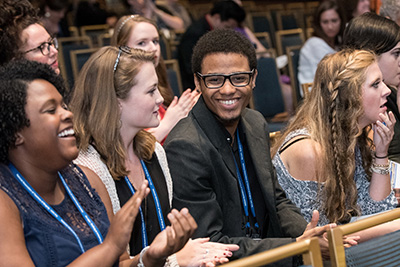Breakout Session
Do We Hallucinate Vowels? Rethinking How We Teach Formants, with Practical Implications for the Female Secondo Passaggio
Saturday, July 9 • 9:00 a.m. - 10:00 a.m.
Presenter: Ian Howell
Introduced by: Lloyd Mims
Location: Chicago Ballroom ABC – 5th Floor
The manner in which vocal tract formants interact with vocal source harmonics is perhaps the most important aspect of acoustic science to be under-utilized by voice teachers. I believe that this is due, at least in part, to the manner in which formant/harmonic interactions are currently presented in the vocal pedagogy literature, based on the model of the spectral envelope of speech-level vowels. This presentation uses affordable software to demonstrate that that the spectral envelope may be productively broken into smaller units of timbre, and that this aural framework may be beneficially integrated into the vocal pedagogy classroom. I will present new models that incorporate relevant psychoacoustic phenomena into the teaching of formants, and demonstrate ear training exercises that bring clarity to our perception of a well-registered voice—with especially practical implications for the female (and countertenor) secondo passaggio.
About Ian Howell
 Praised by the New York Daily News for his “rich voice, capable of great dramatic force,” and San Francisco Classical Voice for the “heart at the core of his soulful sound,” Ian Howell sings with a warm and seamless tone rarely heard from countertenors. He has sung with Florentine Opera, New York City Opera, and Opera London, and with most major North American baroque orchestras. Mr. Howell has recorded for the American Bach Soloists, Warner Classics, Rhino, and Gothic labels. He can also be heard with the all male chamber choir Chanticleer on multiple albums, including the Grammy award winning "Lamentations and Praises." Mr. Howell joined the voice faculty at the New England Conservatory of Music in 2014, where he teaches voice pedagogy and directs the NEC Voice and Sound Analysis Lab.
Praised by the New York Daily News for his “rich voice, capable of great dramatic force,” and San Francisco Classical Voice for the “heart at the core of his soulful sound,” Ian Howell sings with a warm and seamless tone rarely heard from countertenors. He has sung with Florentine Opera, New York City Opera, and Opera London, and with most major North American baroque orchestras. Mr. Howell has recorded for the American Bach Soloists, Warner Classics, Rhino, and Gothic labels. He can also be heard with the all male chamber choir Chanticleer on multiple albums, including the Grammy award winning "Lamentations and Praises." Mr. Howell joined the voice faculty at the New England Conservatory of Music in 2014, where he teaches voice pedagogy and directs the NEC Voice and Sound Analysis Lab.
